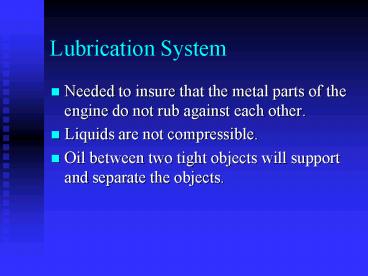Lubrication System PowerPoint PPT Presentation
1 / 22
Title: Lubrication System
1
Lubrication System
- Needed to insure that the metal parts of the
engine do not rub against each other. - Liquids are not compressible.
- Oil between two tight objects will support and
separate the objects.
2
Basic Parts of Lubrication System
- Oil pan- holding tank for oil.
- Sump- Lowest part of oil pan.
- Oil Pump- Pumps oil through engine. Creates
pressure on oil. Has a pressure relief valve. - Gallery- Passageways for oil throughout engine.
- Oil Filter- Filters oil or cleans the oil
- Dipstick- used to check the level of oil
3
Friction
- Resistance to movement between any two objects
when placed in contact with each other. - Friction is constant, but it depends on the type
of surface, pressure holding the two objects
together, etc.
4
Friction causes
- Heat
- Wear
- Loss of HP
5
5 Jobs of Oil
- Lubricates- Separates metal parts.
- Cools- Oil flows to oil pan and is cooled by
passing air. - Cleans- Absorbs small particles.
- Seals- Seals on intake stroke between piston and
cylinder walls. - Absorbs Shock- Absorbs pressure of piston on
power stroke.
6
SAE
- Society of Automotive engineers
- Viscosity Rating- How thick or thin oil is.
- Viscosity- A liquids ability to resist flow.
7
Viscosity Weights
- 10- very thin
- 20- slightly thicker
- 30- Average mild climate
- 40- Hotter climate
- 50- Thickest
- 90-150- Differential oil and some standard
transmissions
8
Multi Viscosity
- 10w 40
- Meets requirements of two or more SAE standards.
- W- stands for oil that has been tested at 0ºF.
(winter tested)
9
API
- American Petroleum Institute gives oil Service
rating - Oil Service Rating- Tells how well the oil will
work in a specific year and make model of a
vehicle. - Also tells how well an oil lubricates, prevents
corrosion, resist foaming, and cleans. - S Standard- Passenger cars
- C Commercial- Diesel
10
Oil Ratings
- SA- Lowest grade oil, not used in cars.
- SB- Has Few additives, not used in cars.
- SC- Used in cars up to 1964.
- SD- 1964-1971 used in high horse power cars.
- SE- Pollution controls began 1971-1979.
- SF- 1980-1988 (turbo) created more heat.
- SG- 1989-1994, additives to fuel.
- SH- 1994-1996, higher revving engines, more
overhead cams. - SJ- 1996
- SL- As of 2002
11
Diesel Ratings
- CA- Light Duty.
- CB- Minimum duty.
- CC- Semi Duty.
- CD- Extra Heavy Duty.
- CE- Until 1999
- CF- 2000
- CG-2001
- CH-2002
12
Bearing Clearance
- Oil clearance or bearing clearance. The amount of
space left for the oil to flow. - It should be .002 or two-thousandths
13
Oil Pressure
- It is controlled by two things.
- 1. The speed of the oil pump. The faster the
engine runs the faster the pump goes. This will
increase oil pressure. - 2. A pressure relief valve in pump. This will
determine the maximum pressure the pump can
create.
14
Oil Change
- Should be based on miles driven not the color of
the oil. - Should change oil every 3000 to 6000 miles
- Many factors will help you to determine whether
you should change oil every 3000, 4000, 5000, or
6000 miles.
15
What determines whether you change your oil more
often or wait longer?
- Engine is driven for reasonably long time?
- Engine in good mechanical condition?
- Engine runs between 180º and 200º?
- Air filter Good?
- Oil Filter Good?
- Good Clean PCV System?
- Fuel System work properly?
- Engine run at moderately high speeds?
- Engine driven in clean enviroment?
16
PCV
- Positive Crankcase Ventilation System
- Crankcase- Area around the crankshaft, above the
oil pan and below the pistons. - While on the power stroke, blow by gases escape
past the piston rings and go into the crankcase
17
(No Transcript)
18
PCV System
- Remove blow-by gases from the crankcase and sends
them into the intake manifold and then sent back
to the engine to be reburned.
19
PCV Valve
- Flow control valve Regulates how much blow-by
goes back into the engine. - At idle, very little should go back into the
engine, because it could create a lean mixture. - Controlled by engine vacuum.
- Vacuum is high at idle and decreases as the
throttle opens
20
(No Transcript)
21
Problem vs. Symptom
- PROBLEMS
- PCV valve hose leak.
- PCV valve stuck open.
- PCV valve stuck closed or valve clogged.
- SYMPTOMS
- Rough at idle hissing noise.
- Rough at idle Hissing noise.
- Excessive pressure in crankcase oil leaks or oil
in air filter
22
Gaskets and Seals
- Gasket- used to seal between non-moving metal
parts. Made of treated paper, thin metal, cork,
rubber. - Seals- used to prevent leaks around a moving and
non-moving part. Uses a rubber edge to push
liquid away from shaft.

